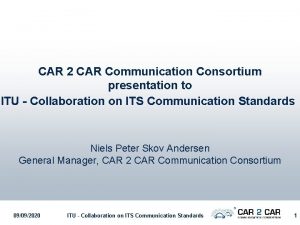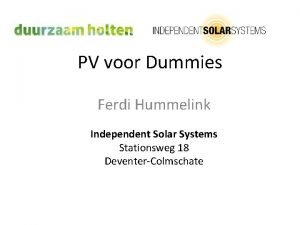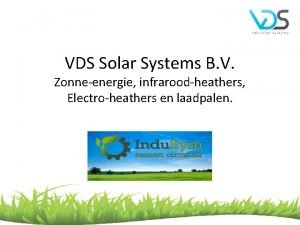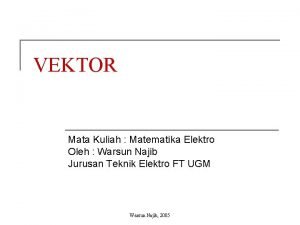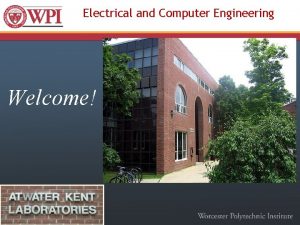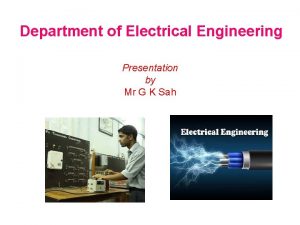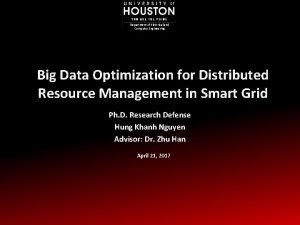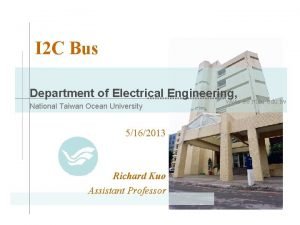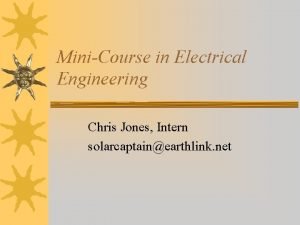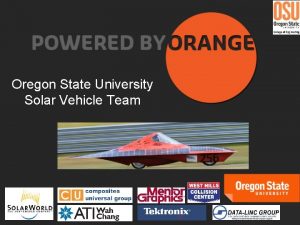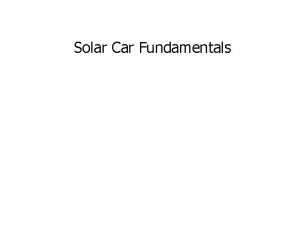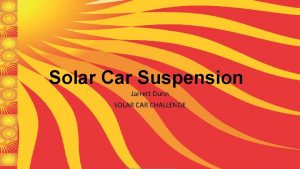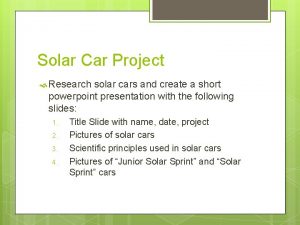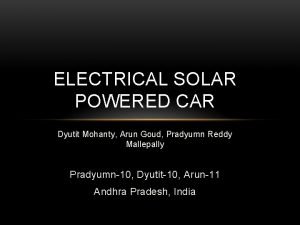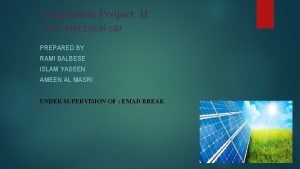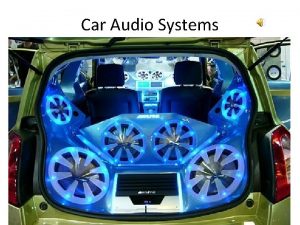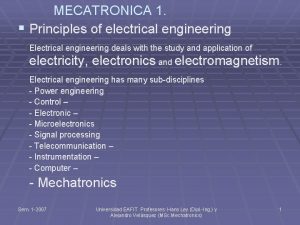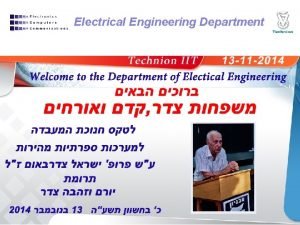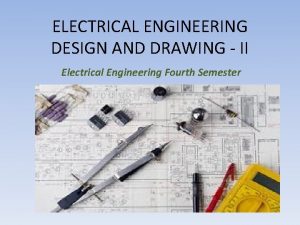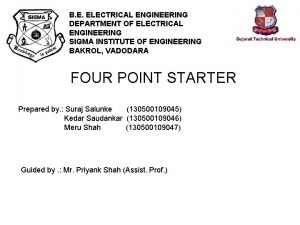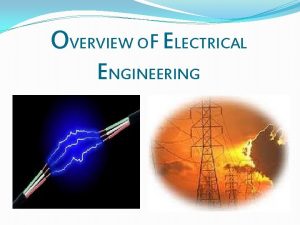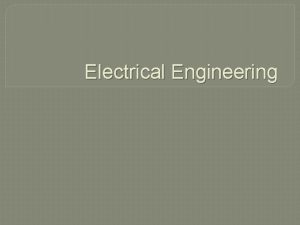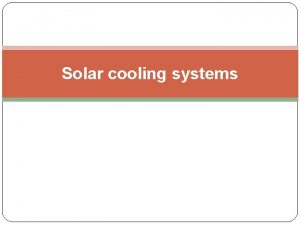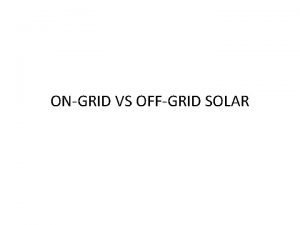MiniCourse in Electrical Engineering Solar Car Electrical Systems




























- Slides: 28

Mini-Course in Electrical Engineering Solar Car Electrical Systems, Battery Technology, and Safety Issues William Shih, Deputy Race Director 1

Electrical System Overview • Solar Array • Maximum Point Power Trackers • Batteries • Motors / Motor Controllers • Other Electrical Components 2020 Fall Webinar Series Mini-Course in Electrical Engineering © Solar Challenge Foundation 2

Solar Array Design Options • Flat Solar Arrays • Easier to execute • Angle to sun less of a concern • Curved Solar Arrays • Brittle solar cells can break when flexed • Mounting to solar car may be tricky • Angle to sun more of a concern 2020 Fall Webinar Series Mini-Course in Electrical Engineering © Solar Challenge Foundation 3

Solar Array Choices • Pre-made Commercial Panels • Reliable • Easily purchased • HEAVY (glass front adds weight) • Pre-made Specialty Panels • Lightweight option 2020 Fall Webinar Series Mini-Course in Electrical Engineering © Solar Challenge Foundation 4

Solar Array Choices • Raw cells and lamination (e. g. custom arrays) • • Planning has to start FAR in advance (you are probably too late already!) Process is expensive Panels are very light and can be built to fit your car Easy to maximize power and reduce aerodynamic drag 2020 Fall Webinar Series Mini-Course in Electrical Engineering © Solar Challenge Foundation 5

Solar Array Choices • Do-it-yourself solar array • Amazing learning experience • Learning curve is steep • Hard to find raw cells (contact Sun. Power directly) • Takes a lot of man power • Hard to watch when cells are continually breaking • Can fit exactly to your car 2020 Fall Webinar Series Mini-Course in Electrical Engineering © Solar Challenge Foundation 6

Do-it-yourself 2020 Fall Webinar Series Mini-Course in Electrical Engineering © Solar Challenge Foundation 7

Electrical System Overview • Solar Array • Maximum Point Power Trackers • Batteries • Motors / Motor Controllers • Other Electrical Components 2020 Fall Webinar Series Mini-Course in Electrical Engineering © Solar Challenge Foundation 8

Maximum Point Power Trackers (MPPTs) • Moving power from the solar array to the batteries is not as easy as hooking up a couple of wires! • Voltage from your solar array needs to match the voltage of the battery pack. • Maximum Power Point Trackers adjust voltage and current from your array to give you the most possible power to your vehicle. 2020 Fall Webinar Series Mini-Course in Electrical Engineering © Solar Challenge Foundation 9

MPPT Considerations • Buck vs. Boost • Buck = Vout < Vin • Boost = Vout > Vin • Battery/System Voltage (Vout) • Greatest options for <= 48 V • One option > 72 V (AERL) • Current (ISC) or Power Rating • Efficiency: typically > 95% 2020 Fall Webinar Series Mini-Course in Electrical Engineering © Solar Challenge Foundation 10

MPPT Choices • AERL (Australian Energy Research Laboratories) Race. Max 600 B • Needed for Vout > 72 V • Nomura MPPT • Small/light, Vout = 34. 5 V • Mid. Night Solar / Outback Power (and other grid type MPPTs) • Genasun • DC-DC Converters Don’t do this! https: //www. facebook. com/Nomura. Co/photos/a. 2709579579286363/2709579905952997/ 2020 Fall Webinar Series Mini-Course in Electrical Engineering © Solar Challenge Foundation 11

Electrical System Overview • Solar Array • Maximum Point Power Trackers • Batteries • Motors / Motor Controllers • Other Electrical Components 2020 Fall Webinar Series Mini-Course in Electrical Engineering © Solar Challenge Foundation 12

Batteries • Choose carefully! • Batteries are one of the areas where you get what you pay for. • Decisions to make: • What voltage does your car run at? (Higher voltage means lower current. ) • How much weight can you carry? • How much energy can you get at that weight? • Can your solar panels recharge the battery pack? • Is it a road race or a track race? 2020 Fall Webinar Series Mini-Course in Electrical Engineering © Solar Challenge Foundation 13

Batteries: 5 k. Wh Limit • The 5 kilowatt-hour (k. Wh) rule • k. Wh = Amp-hours x Voltage • Calculated at the 20 hour discharge rate • Example: • Four, 12 volt, 84 amp-hour batteries in series • 84 Ah x 48 V = 4032 Wh or 4. 032 k. Wh • (this battery pack would weigh around 230 pounds) 2020 Fall Webinar Series Mini-Course in Electrical Engineering © Solar Challenge Foundation 14

Batteries: Effect of Peukert’s Number • Choosing batteries based on the Peukert number: • A typical sealed lead acid battery has a Peukert number between 1. 1 and 1. 3. (The closer to 1. 0 the better!) 2020 Fall Webinar Series Mini-Course in Electrical Engineering © Solar Challenge Foundation 15

Batteries: Don’t rely on specs • Testing batteries: • Understanding how your batteries perform is one of the most important things you can know BEFORE the race starts. • Carefully recording voltage, current, and amphours will help your team make good decisions during the race 2020 Fall Webinar Series Mini-Course in Electrical Engineering © Solar Challenge Foundation 16

Lithium-based Chemistries • Permitted only in Advanced or Cruiser Divisions • 5 k. Wh capacity limit calculated at 1 C • Multiple Chemistry Types • Lithium-Ion: Higher energy density (150 -200 Wh/kg), lower discharge rate (1 C) • Lithium Iron Phosphate: Lower energy density (90 -120 Wh/kg), higher discharge rate (1 -25 C), better thermal/chemical stability Li. Fe. Mn. PO 4 Prismatic Battery Prismatic Pouch • Advantages: • Better charge/discharge efficiency • Lighter (higher energy density) • Requires Battery Management System (BMS) to prevent overcharge and overdischarge 2020 Fall Webinar Series Mini-Course in Electrical Engineering Individual Li-Ion 18650 Cells © Solar Challenge Foundation 17

Electrical System Overview • Solar Array • Maximum Point Power Trackers • Batteries • Motors / Motor Controllers • Other Electrical Components 2020 Fall Webinar Series Mini-Course in Electrical Engineering © Solar Challenge Foundation 18

Electric Motors • Brushed Electric Motors • Inexpensive • Lower overall efficiency • Controller is inexpensive and easy to wire • Brushless Electric Motors • More efficient • More expensive than brushed motors • Controller is more difficult to wire (typically 3 phase) 2020 Fall Webinar Series Mini-Course in Electrical Engineering © Solar Challenge Foundation 19

Motor Efficiency Curves Maximum Efficiency Higher RPM Lower RPM 2020 Fall Webinar Series Mini-Course in Electrical Engineering © Solar Challenge Foundation 20

Hub Motor • NGM ‘Direct Drive’ high efficiency inhub motor with variable air gap adjustment. • Super efficient over a broad range of speeds • No need for gears or chain • Very expensive (Motor + controller > $25, 000) • Mitsuba / Nomura hub motors replacing NGM as favored motor for solar car teams • Still ~$25, 000 2020 Fall Webinar Series Mini-Course in Electrical Engineering © Solar Challenge Foundation 21

Pulse Width Modulation (PWM) Controller • Brushed Motors – Alltrax AXE • • Easy to wire 0 -5 k Pot control Programmable Durable • Brushless Motors – Sevcon • Supports 3 -phase motors • Includes safety interlocks (e. g. driver present) 2020 Fall Webinar Series Mini-Course in Electrical Engineering © Solar Challenge Foundation 22

Electrical System Overview • Solar Array • Maximum Point Power Trackers • Batteries • Motors / Motor Controllers • Other Electrical Components 2020 Fall Webinar Series Mini-Course in Electrical Engineering © Solar Challenge Foundation 23

Electrical System • Main electrical system (i. e. propulsion) (the one that makes your car move) • Use the correct gauge wire for the job • Disconnect switches should be designed for DC • Fuses • Secondary electrical system (everything else on your car) • Lights • Fans • Horn 2020 Fall Webinar Series Mini-Course in Electrical Engineering © Solar Challenge Foundation 24

Disconnect Switches/Fuses • Disconnect Switches • Be sure they are rated for DC and for system voltage • Teams generally use Albright ED 250 disconnect • Relays • New choice for 2021 • Can put 12 V switch in driver component to control relay coil • Minimizes high-voltage wires around driver and length of runs • Fuses • Need to be rated for DC and for system voltage • Any speed fuse is now allowed (no fast-blow required) 2020 Fall Webinar Series Mini-Course in Electrical Engineering © Solar Challenge Foundation Albright ED 250 Rated load: 400 A Break Current: 1200 A @ 48 V DC (600 A @ 96 V DC) Giga. Vac GV 200 12 V Coil Control Rated Load: 500+ A Rated Voltage: 12 -800 VDC Bussman FWH Fuse 500 V DC @90 amp fuse is about $50 25

Low Voltage Indicator Do-It-Yourself kit available at: http: //store. qkits. com/ Look for “Low Voltage Alarm” 2020 Fall Webinar Series Mini-Course in Electrical Engineering © Solar Challenge Foundation 26

Electrical System “Gotchas” • Main Electrical System • Loose battery terminals/connections • Grounding to the frame (nicks in wires, bad isolation on mounting hardware) • Wire insufficient for rated current • Disconnects or fuses incorrectly rated • Secondary Electrical System • Grounding to the frame (especially due to telemetry) • Not isolated from main electrical system • Switch reliability (especially brake switches) • Loose connections or crimp connectors 2020 Fall Webinar Series Mini-Course in Electrical Engineering © Solar Challenge Foundation 27

Mini-Course in Electrical Engineering Solar Car Electrical Systems, Battery Technology, and Safety Issues William Shih, Deputy Race Director 28
 If car a passes car b then car a must be
If car a passes car b then car a must be Engineering elegant systems: theory of systems engineering
Engineering elegant systems: theory of systems engineering Elegant systems
Elegant systems Solar panel cells wholesale
Solar panel cells wholesale An inexhaustible source of energy
An inexhaustible source of energy Car to car communication consortium
Car to car communication consortium Ch7on
Ch7on Independent solar systems
Independent solar systems Slt 800 solar light tower factories
Slt 800 solar light tower factories Vds solar systems
Vds solar systems Car wash payment systems
Car wash payment systems Pengurangan vektor
Pengurangan vektor George washington university electrical engineering
George washington university electrical engineering Tel aviv university electrical engineering
Tel aviv university electrical engineering Northwestern university computer engineering
Northwestern university computer engineering Klipsch school of electrical and computer engineering
Klipsch school of electrical and computer engineering Electrical engineering department
Electrical engineering department Umd ee
Umd ee Concealed wiring
Concealed wiring Electrical engineering environmental issues
Electrical engineering environmental issues Wpi ece department
Wpi ece department Electrical engineering presentation
Electrical engineering presentation Kfupm ee faculty
Kfupm ee faculty Big data in electrical engineering
Big data in electrical engineering Define electrical engineering
Define electrical engineering Basic electrical engineering kulshreshtha
Basic electrical engineering kulshreshtha University of belgrade school of electrical engineering
University of belgrade school of electrical engineering Electrical engineering notation
Electrical engineering notation Ntou ee
Ntou ee





